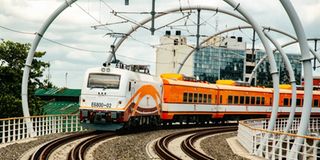Prime
Inside CCM’s bid to turn Tanzania into East Africa’s transport nerve centre

What you need to know:
- Outlined in its 2025–2030 election manifesto, the plan aims to fully leverage Tanzania’s geographic location to serve as a critical gateway for trade and mobility across the continent, particularly for the seven landlocked countries that depend on its ports.
Dar es Salaam. With bold pledges to complete the Standard Gauge Railway (SGR), expand strategic highways, and transform key ports, Tanzania’s ruling party Chama Cha Mapinduzi (CCM) has unveiled an ambitious vision to turn the country into East Africa’s primary transport and logistics hub.
Outlined in its 2025–2030 election manifesto, the plan aims to fully leverage Tanzania’s geographic location to serve as a critical gateway for trade and mobility across the continent, particularly for the seven landlocked countries that depend on its ports.
“Transport infrastructure is not just an economic enabler—it’s the backbone of regional integration and national progress,” the manifesto declares.
The SGR
At the heart of the vision is the rapid expansion of the Standard Gauge Railway network. Over the next five years, CCM promises to complete the remaining segments of the SGR: Mwanza–Isaka (341 km), Makutupora–Tabora (368 km), Tabora–Isaka (165 km), and Tabora–Kigoma (506 km).
These lines will link the Indian Ocean port of Dar es Salaam to key inland hubs and onward to Rwanda, Burundi, and the Democratic Republic of Congo.
A new SGR line from Mtwara Port to Mbamba Bay, with a branch to Songea and Ludewa, is also in the pipeline to serve the mineral-rich Liganga and Mchuchuma zones.
Additionally, CCM plans to launch a 1,108-km line from Tanga Port through Arusha to Musoma, connecting with the central rail corridor and creating a north-south axis of commerce.
To maximise these investments, the party promises to finalise cargo-handling infrastructure and expand urban commuter rail in Dar es Salaam and Dodoma to ease congestion and improve last-mile mobility.
Port expansion: Bagamoyo resurfaces
The manifesto resurrects the long-anticipated Bagamoyo Port as a cornerstone project. Designed to be one of the largest deep-water ports in Africa, Bagamoyo will complement existing ports in Dar es Salaam, Tanga, and Mtwara.
A proposed oil terminal capable of docking four tankers at once and 420,000 square metres of fuel storage infrastructure are included in the plan.
Dry ports in Kurasini, Kwala, and Ihumwa will serve as inland logistics hubs, enabling faster cargo clearance and reducing congestion at sea ports.
For regional integration, CCM proposes a new marine route linking South Unguja in Zanzibar to the mainland via Bagamoyo.
Road network
The manifesto places significant emphasis on major road projects that are essential for boosting cross-border trade and enhancing domestic connectivity.
Among the priority corridors earmarked for completion or upgrading are the 161-kilometre Dar es Salaam–Lindi road, which will improve access to the southern regions; the 477-kilometre Central Corridor running through Morogoro, Dodoma, Singida, and Mwanza, serving as a vital economic artery; and the 646-kilometre highway linking Dar es Salaam to Arusha via Chalinze and Segera.
Additionally, the TANZAM highway—Tanzania’s key road connection to Zambia—is set for upgrades to strengthen transport links within the Southern African region.
Why it matters
Tanzania’s transport agenda is closely aligned with regional goals under the East African Community (EAC), the Southern African Development Community (SADC), and the Common Market for Eastern and Southern Africa (Comesa).
Improved infrastructure is expected to cut transport costs, accelerate the movement of goods, and enhance competitiveness across the region.
“The manifesto’s infrastructure vision dovetails with the African Continental Free Trade Area (AfCFTA), making Tanzania a natural trade facilitator,” says, a logistics and regional integration expert who spoke on condition of anonymity.
Can ambition meet financing?
While the blueprint is comprehensive and potentially transformative, it also raises questions about feasibility. Many of the flagship projects—Bagamoyo Port, SGR expansion, and metro systems—require billions in funding.
Past delays due to financing gaps, contractor disputes, or regulatory issues remain cautionary tales.
However, CCM maintains that strategic public-private partnerships, concessional loans, and improved tax collection will unlock the required resources.
If executed successfully, CCM’s vision could reposition Tanzania not just as a land of transit, but as a continental logistics powerhouse. The challenge will lie in translating political will into timely, well-managed delivery—connecting promises to pavement, ports, and prosperity.





